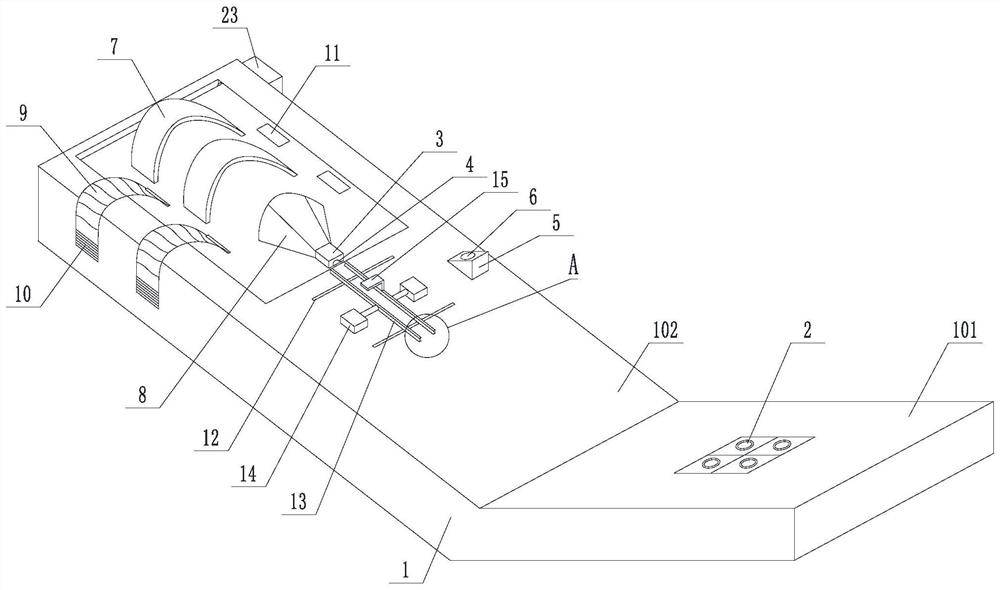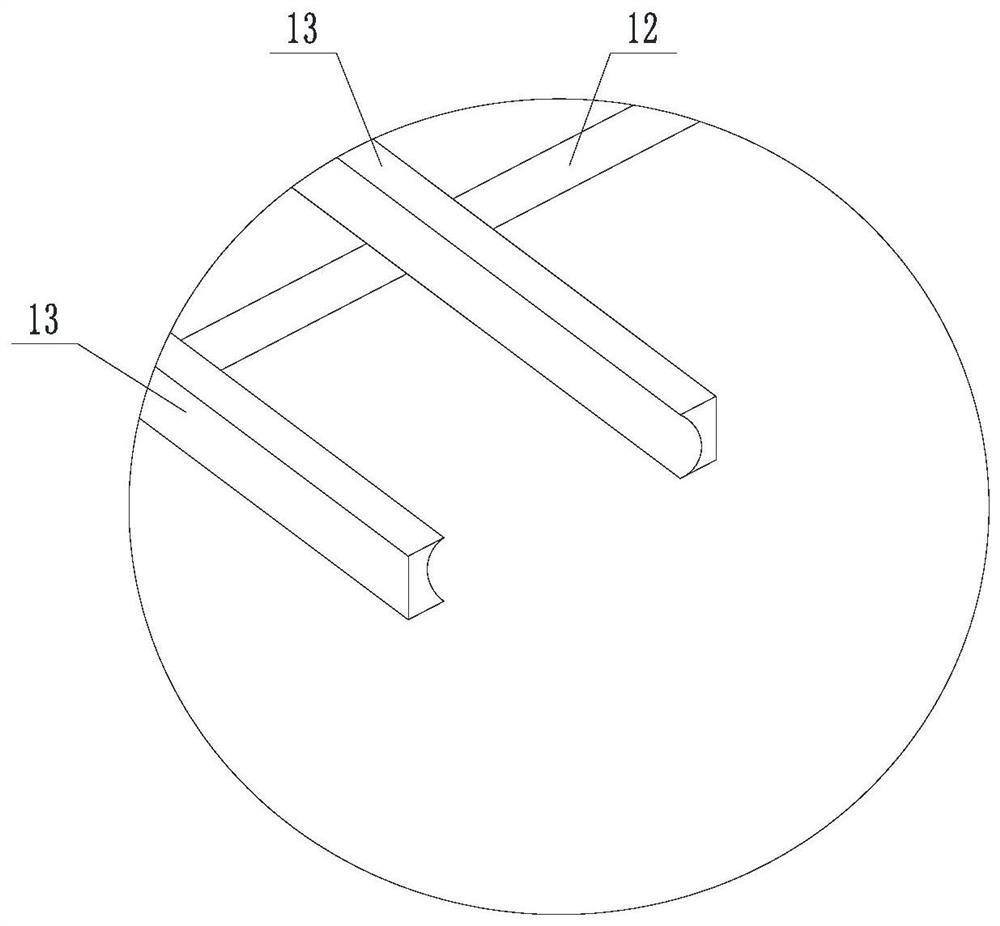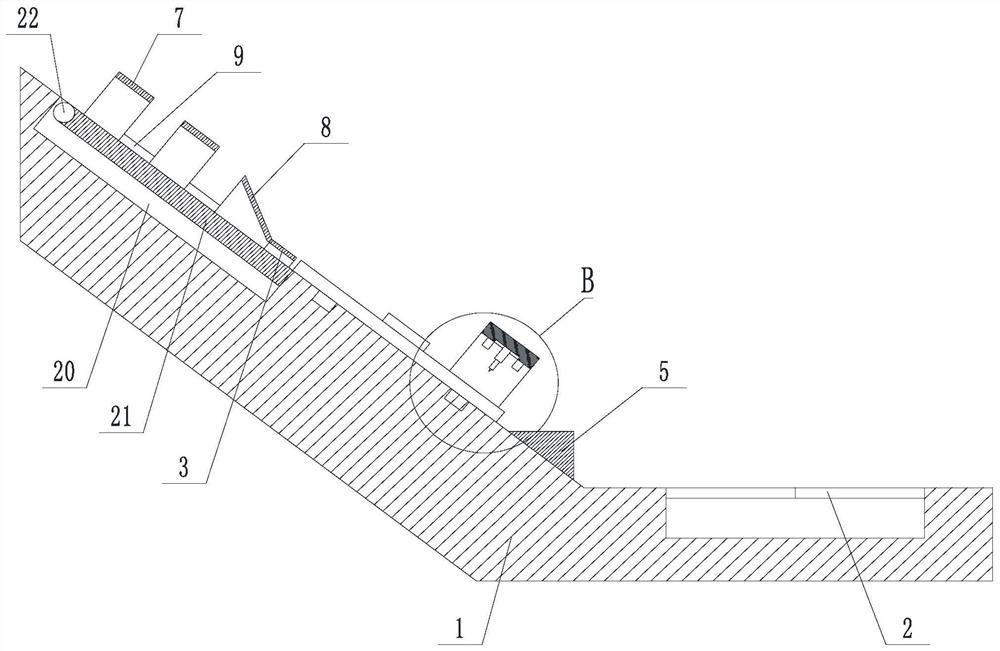A mouse tail vein blood collection system
A tail vein and rat tail technology, applied in the field of medical experiments, can solve the problems of air bubbles, interference, and difficulty in ensuring the stability of the tail, and achieve the effects of overcoming air bubbles, reducing the amount of air bubbles, and avoiding interruption of blood collection
- Summary
- Abstract
- Description
- Claims
- Application Information
AI Technical Summary
Problems solved by technology
Method used
Image
Examples
Embodiment 1
[0042] Such as figure 1 and figure 2 A mouse tail vein blood collection system shown includes a table body 1. The table body 1 includes a horizontal plane 101 and an inclined plane 102. A centrifugal device 2 is arranged on the horizontal plane 101. A rat body fixing assembly, Mouse tail positioning device 3, mouse tail clamping assembly, the mouse tail positioning device 3 includes a passage 4 for the mouse tail to pass through; also includes a bearing platform 5 on the inclined plane 102, the upper surface of the bearing platform 5 is parallel to the horizontal plane 101, and An insertion hole 6 for placing an EP tube is opened on the upper surface of the platform 5 .
[0043] Wherein, the mouse body fixing assembly includes several arc-shaped stoppers 7, a semi-conical cylinder 8 between the arc-shaped limiters 7 and the mouse tail positioning device 3, and the height and width of the internal passage of the semi-conical cylinder 8 are all along the The inclined directio...
Embodiment 2
[0046] Such as Figure 1 to Figure 4 A mouse tail vein blood collection system shown, on the basis of Embodiment 1, the mouse tail clamping assembly includes the first slide rail 12 arranged on the inclined plane 102, two slide rails 12 that are slidably fitted on the first slide rail 12 One clamping rod 13, the axis of the first slide rail 12 is parallel to the horizontal plane 101; any one clamping rod 13 is connected to the first driving member 14 on the side away from the direction where the other clamping rod 13 is located, and the first driving The member 14 is used to drive the connected clamping rod 13 to move linearly along the first slide rail 12 . The surface of one side of any clamping rod 13 facing the direction of the other clamping rod 13 is a concave arc surface. The top of one of the clamping rods 13 is connected to the mounting part 15, and the mounting part 15 extends toward the direction of the other clamping rod 13; Attach blade 18. The bottom surface o...
Embodiment 3
[0060] On the basis of Embodiment 2, a groove 20 is provided on the inclined surface 102, and a bearing plate 21 is arranged in the groove 20. The top of the bearing plate 21 is rotationally connected with the side wall of the groove 20 through a rotating shaft 22, and is also included for driving the rotating shaft 22 to rotate. The third driving member 23; the mouse body fixing assembly and the mouse tail positioning device 3 are all located on the bearing plate 21. The carrying plate 21 is a magnetic metal plate. Rat tail positioning device 3 such as Figure 5 As shown, several magnets 24 are embedded in the bottom; the channel 4 is open from the bottom surface of the mouse tail positioning device 3 , and the inner wall of the channel 4 is covered with a layer of elastic material 25 .
[0061] Preferably, the magnetic metal plate is an iron plate, and the elastic material is a rubber pad.
[0062] In the blood taking process of the present embodiment:
[0063] Step S2 is...
PUM
 Login to View More
Login to View More Abstract
Description
Claims
Application Information
 Login to View More
Login to View More - R&D
- Intellectual Property
- Life Sciences
- Materials
- Tech Scout
- Unparalleled Data Quality
- Higher Quality Content
- 60% Fewer Hallucinations
Browse by: Latest US Patents, China's latest patents, Technical Efficacy Thesaurus, Application Domain, Technology Topic, Popular Technical Reports.
© 2025 PatSnap. All rights reserved.Legal|Privacy policy|Modern Slavery Act Transparency Statement|Sitemap|About US| Contact US: help@patsnap.com



